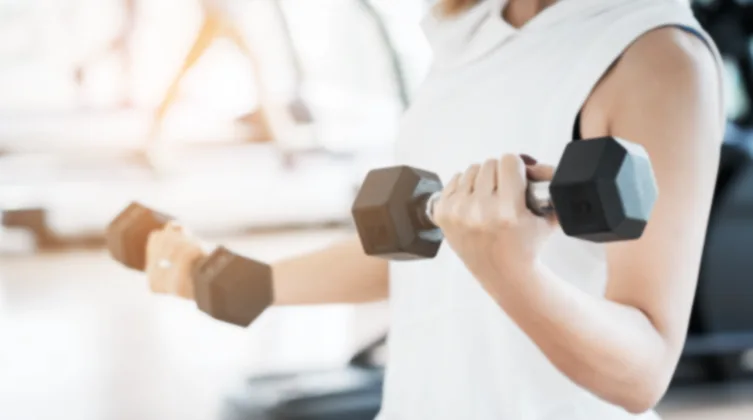I’ve spent way too much thought power the past month trying to refine my fitness goals for 2018. Since I used to be a competitive dancer and cheerleader, always with a competition in sight, I’m struggling with the no end-point. Sure exercise for health ought to be enough of a driver… But it ain’t scratching the current itch.
Insert, I want to build more muscle = more hypertrophy training.
Without adding fat mass or “bulk”. This means building more overt muscle, whilst leaning out (or maintaining my current weight), essentially.
So this had me thinking?
Can you build muscle + lose fat?
A quick google search and read around (mostly on body building forums) might have you temptingly conclude “no” – with persuasive arguments around calorie surpluses and deficits. Respondents gripping earnestly to laws of thermodynamics and with little to no reference to the cellular and/or molecular biology.
Something like this:
- Building muscle requires energy storage. Fat burning requires energy loss. One is catabolic and the other anabolic.
- Ones requires an energy (calorie) surplus. The other requires an energy (calorie) deficit.
- And therefore the two cannot be harmonious. Or can they?
The first of these points is true. The second lies in some grey area but is mostly true. And the third, well let’s explore further…
So after my initial scan of the big WWW…I wasn’t convinced, not without further evidence and delving into some of the scientific literature myself.
My science degree and postgraduate studies had taught me that muscle synthesis and fat metabolism are two distinct biochemical processes. Your body directs and prioritizes energy to muscle and fat tissue distinctly. So theoretically, it could be possible to burn fat and build muscle simultaneously.
First, we’ll explore the biological mechanisms in order to gain a comprehensive appreciation for what’s actually occurring here at the molecular level, and then we’ll delve into some real life examples.
How does your body build muscle?
Muscles need a reason to grow bigger and stronger. That reason is mechanical stress and cellular injury – a common, overt and effective example of mechanical stress is weight lifting.
When you lift weights, you place “stress” on your muscles (and skeleton, joints, nervous system). Your body responds to this “stress” or loads by adapting i.e. building better, bigger, stronger muscles.
This is why progressive overload is key. Your body will adapt to each new load. Your body is evolutionary smart and designed for survival. Your body cannot tell the difference between a safe but rigorous weight lifting session and a true danger or threat. Your body thinks; evolve or be killed. It’s that primitive.
Side Note: an exception to the muscle hypertrophy described above is the newbie – the untrained individual who embarks upon a hypertrophy program. In the initial phase, the majority of their gains are strength, not growth, due to neural adaption. The mind-muscle connection responds first but within a few short weeks of consistent training, muscle growth will eventually take over as the dominant factor.
Converse to muscle growth, is muscle atrophy. Disuse atrophy, as it’s called, occurs when muscles are not stimulated for an extended period of time (e.g. sedentary life-style, desk job, injury, bed-rest).
If you don’t use it, you lose it.
If you use it, you adapt.
Hypertrophy Explained.
When you stress your muscles, you cause micro-damage. This stimulates additional muscle protein breakdown (MPB) and muscle protein synthesis (MPS). Additional – because your body is always doing these two processes.
Muscle stress also stimulates hormones – growth hormone, cortisol, insulin-like growth factor, testosterone, etc. which are all part of the harmonious amino acid and energy recycling processes.
The body responds to skeletal muscle micro-damage with super compensation (the adaptation mentioned above).
- by mopping up damage and laying down more sarcomeres – the most basic contractile unit of skeletal cells.
- by expanding the extracellular matrix and sarcoplasm (e.g. collagen, glycogen stores).
- by recruiting satellite cells (1).
Together these myogenic events ultimately lead to an increase in muscle size (hypertrophy).
BUT your body needs substrates for growing muscle. Sure.
Most of these it gets from food. Some it recycles.
You’ve certainly heard you need protein to take advantage of the additional MPS that occurs with exercise. And you do, if maximum gains, minimum losses and a lean physique are your goal. More on that later.
How does your body lose fat?
Residing within your adipose (fat) tissue are billions of tiny fat cells. We all have them. And they serve many purposes beyond the fat storage we’re focused on here.
Within each tiny fat cell are triglycerides (a type of fat). When we lose fat, triglycerides are recruited for energy production.
First they are hydrolyzed (split) into glycerol and fatty acids. This process is called lipolysis. Next they are converted into acetyl coenzyme A (acetyl CoA). Acetyl CoA is then metabolized through the citric acid cycle and electron transport chain to create adenosine triphosphate (ATP; your body’s #1 fuel source; think petrol to cars is like ATP to us humans) and other byproducts such as carbon dioxide and water. The majority of this occurs in the liver and skeletal muscle.
In a nutshell, if you want to know where the majority of fat goes when lost, it’s expelled via the lungs as the byproduct carbon dioxide, according to this article (2).
Admittedly, this is a basic description of fat catabolism for energy utilization. One thing not mentioned was that this process assumes a calorie deficit as the body is recruiting fat for energy.
A calorie deficit can occur due to reduced dietary intake of macromolecules, during a fast or during exercise (there are other contributors but these are the big ones).
When we engage in exercise, inevitably we delve into some fat stores, as you can see from the graphs below (3-4). So reduced calorie consumption may not be necessary to lose fat and gain muscle, if a cleverly executed exercise program and diet is in place.
Beyond The Textbook.
The biology is nice to know and all, but can people actually build muscle and lose fat in real life?
According to a 2015 study, healthy trained men and women (n=48) following a heavy resistance training program (5 days per week) and consuming very high protein diets (2.3 to 3.4 g/kg/day) gained significant lean body mass, reduced fat mass and reduced body fat percentage over 8 weeks (5). Although the study wasn’t without limitations – high dropout rate, reliability of the BodPod® and arguably the normal protein (NP) group was not a true control as the subjects also consumed considerable protein. Furthermore, Antonio et al. in their follow-up studies using a crossover design failed to show equally substantiating results (6-7).
Never mind, there are other studies to appreciate where people gained muscle and lost fat at the same time.
Elite male gymnasts following a 1,973 calorie, ketogenic diet for 30 days and training an average 30 hours per week improved muscle mass and lost fat (8). A small sample and unique demographics, but these men were able to perform 17±4.2 chin-ups where their chest reached the bar. So not newbie stuff here.
Another study involving overweight police officers divided among three intervention groups: hypocaloric diet alone, hypocaloric diet + resistance training + casein (milk protein), and hypocaloric diet + resistance training + whey protein (9). All groups lost weight, but only the resistance trained + protein supplemented groups gained lean muscle mass and enjoyed the greatest losses in body fat percentage (significantly more than the diet alone group!).
Similar trends have been observed here, here and reviewed here. Common among these studies are resistance training concomitant with attention to higher protein consumption.
Where resistance trained athletes were fed a calorie-reduced diet including only the Recommended Dietary Allowance (RDA) (0.8 g/kg/day) for protein, lean body mass fell (10). This is contrary to positive nitrogen balance seen in a comparison group consuming double the amount of protein (1.6 g/kg/day).
Taken together, these studies support the notion that protein intake well above government recommendations is important for minimizing potential lean muscle loss when striving to reduce body fat at the same time.
Another factor, which I haven’t discussed, but is noteworthy, is the rate of body weight and/or fat loss. This should be kept to an absolute minimum in order to preserve lean muscle mass. Hence, the recommendation for body builders to endure long competition preps.
It’s not all roses and butterflies.
Women prepping for an IFBB bikini and/or fitness model competition were able to lose significant body fat over 4-months, however lean mass and muscle size were maintained at best (11). Protein intake was kept extraordinarily high at approximately 3 g/kg/day. Resistance and aerobic training were also high.
Highly trained individuals dieting to achieve very low levels of body fat, therefore, might be cautioned for small losses in lean mass and muscle size, despite high levels of protein intake and resistance exercise.
Conclusion.
It is possible, but not without challenges, to build muscle without gaining fat or even dropping fat. It appears to depend on some individual factors and key nutrition and training strategies.
- Training: The muscles need to be progressively stressed. Your body adapts to the mechanical load by building more muscle. Resistance training is essential.
- Nutrition: Protein intake needs to be optimized. Maximising muscle synthesis and minimising muscle degradation stimulated by training and for energy utilization in a caloric deficit, requires additional protein intake and timing of protein intake. Requirements are well above government recommendations.
- Energy: To minimise lean muscle losses when following a hypocaloric deficit, keep the rate of losses small. Depending on the added level of physical activity and addition of aerobic training, caloric intake from diet can remain stable whilst fat loss still occur.
REFERENCES:
(1) Schoenfeld, BJ. (2010) The mechanisms of muscle hypertrophy and their application to resistance training. J Strength Condit Res; 24(10): 2857-2872.
(2) https://www.sciencealert.com/this-is-where-body-fat-ends-up-when-you-lose-weight?
(3) Romijn, JA. et al. (1993) Regulation of endogenous fat and carbohydrate metabolism in relation to exercise intensity and duration. Am J Physiol; 265(3 Pt 1): E380-91.
(4) Coyle, EF. (1995) Substrate utilization during exercise in active people. Am J Clin Nutr; 61(suppl): 968S-79S.
(5) Antonio, J. et al. (2015) A high protein diet (3.4 g/kg/d) combined with a heavy resistance training program improves body composition in healthy trained men and women – a follow-up investigation. J Int Soc Sports Nutr; 12(1): 39.
(6) Antonio, J. et al. (2016) A high protein diet has no harmful effects: a one-year crossover study in resistance-trained males. J Nutr Metab; 2016.
(7) Antonio, J. et al. (2016) The effects of a high protein diet on indices of health and body composition – a crossover trial in resistance-trained men. J Int Soc Sports Nutr; 13: 3
(8) Paoli, A. (2012) Ketogenic diet does not affect strength performance in elite artistic gymnasts. J Int Soc Sports Nutr; 9(1): 34.
(9) Demling, RH. (2000) Effect of a hypocaloric diet, increased protein intake and resistance training on lean mass gains and fat mass loss in overweight police officers. Ann Nutr Metab; 44(1): 21-9.
(10) Walberg, JL. et al. (1988) Macronutrient content of a hypoenergy diet affects nitrogen retention and muscle function in weight lifters. Int J Sports Med; 9(4): 261-6.
(11) Hulmi, JJ. et al. (2017) The effects of intensive weight reduction on body composition and serum hormones in female fitness competitors. Front Physiol; 7: 689.





